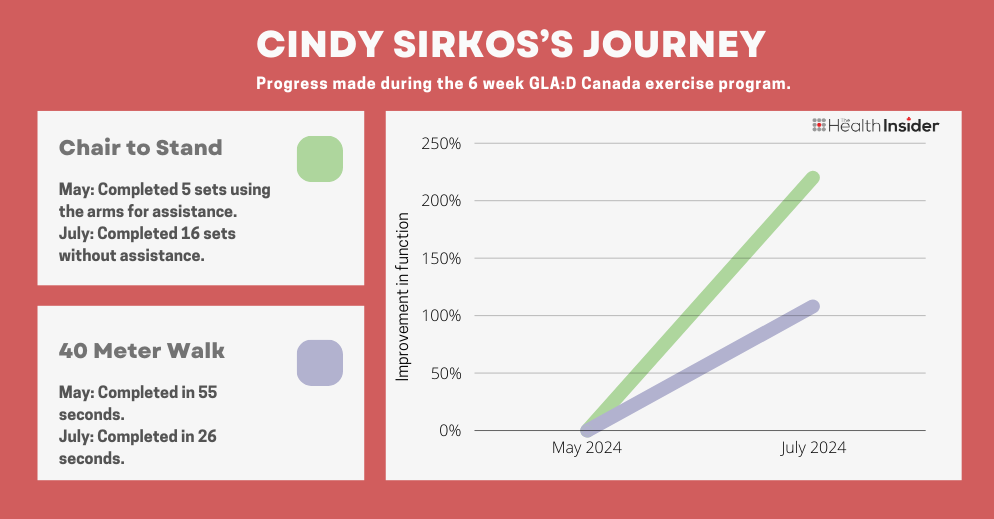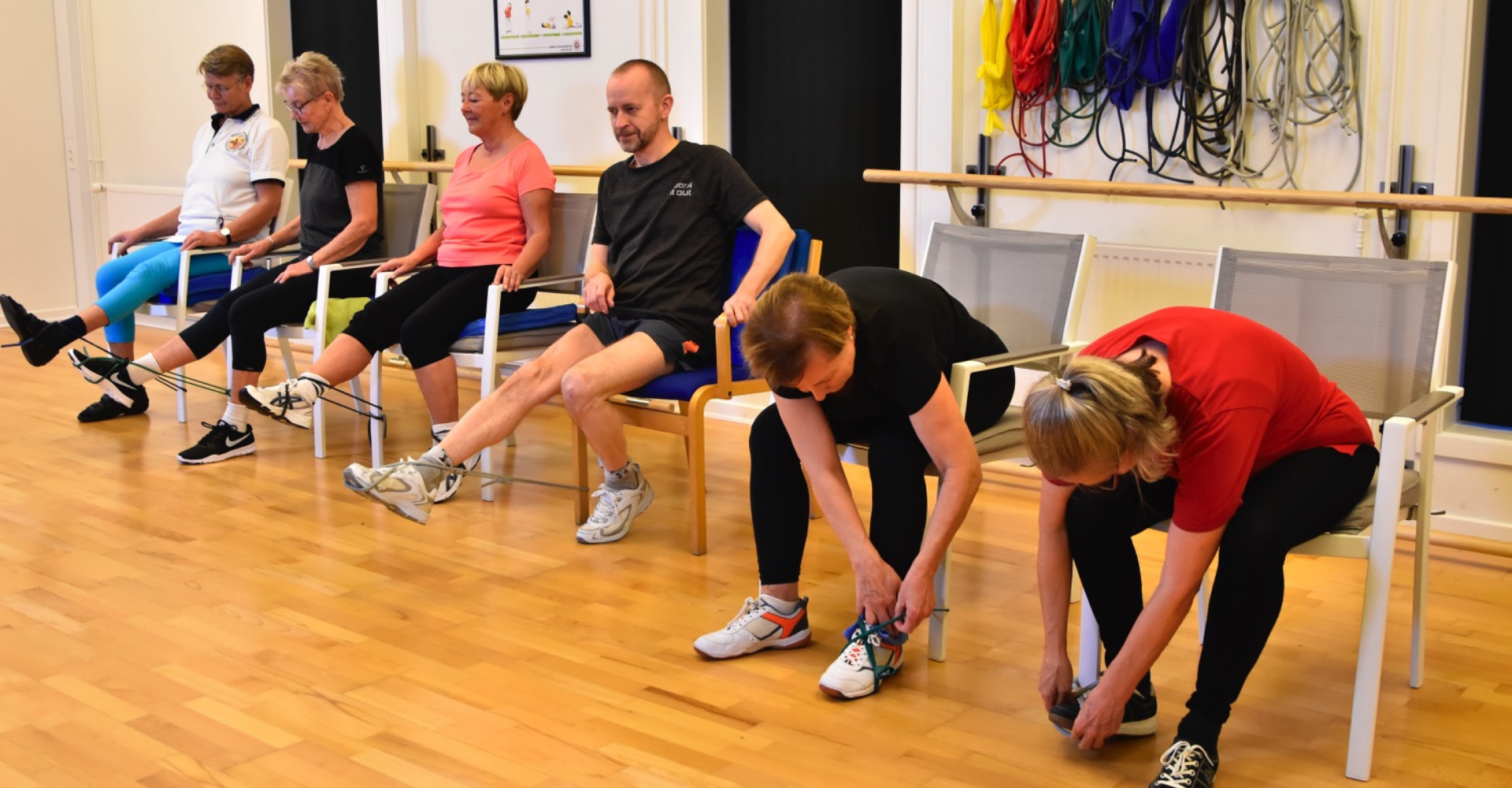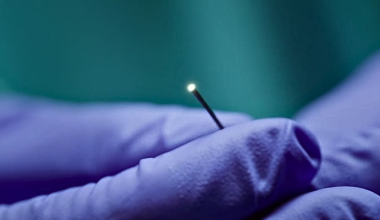With the introduction of the GLA:D program, Canadians with osteoarthritis have an effective option to reduce pain and increase mobility without medication.
Originally from Denmark, the program made its way to Canada in 2021 and is currently available in provinces and territories across the country aside from Quebec and Nunavut.
GLA:D is an exercise and education program designed to relieve pain caused by knee and hip osteoarthritis and improve quality of life.

How GLA:D Works
The program is broken down into three parts designed to keep it a sustainable regimen in the patient’s life for years to come.
Education sessions. Learn more about the causes/risk factors of osteoarthritis, available treatments, and managing your symptoms independently. Participants will join two to three 90 minute sessions before starting exercise classes.
Neuromuscular exercises. A certified therapist will lead hour-long group classes twice a week for six weeks, though it might take you longer than an hour to complete all the exercises. You are encouraged to take it at your own pace. Your therapist will teach you how to continue with the regimen in your own home to continue reaping the rewards. Due to high demand, if you miss more than two exercise classes, you will be kicked out of the program.
Data collection. GLA:D measures and collects your progress data three times: during your first visit, three months after starting the program, and a year after starting the program. GLA:D uses the information to monitor if the program is working and to identify areas of improvement.
The price is set by the clinic and will vary from practice to practice. Expect to pay anywhere from $400-$650. The program is not covered by provincial health insurance, but may be covered by your Extended Health Care Plan. Ask about any program associated costs before starting.
Accessing GLA:D
If you have a family doctor, ask for a referral. They will have to confirm you have osteoarthritis first and may require tests.
Some programs will take participants without a referral from a doctor and can assess you separately. Check with your preferred clinic to see if this is an option.
GLA:D Canada lists disqualifying criteria as:
- You have other reasons for your hip and/or knee problem e.g. soft tissue or connective tissue problems, inflammatory joint disease, fracture or some other disease
- You have other symptoms that are more pronounced than the osteoarthritis problems (for example chronic generalized pain or fibromyalgia)
- You are unable to understand and communicate in English and cannot provide translation for the education and to support you during the exercise program
Where to Find the GLA:D Program Near You
To find the the GLA:D program closest to where you live, click here.
Testimonial: Consistency is Key
Cindy Sirko was diagnosed with osteoarthritis in her lower back, hips, and knees in 2023. She was experiencing excruciating pain which was greatly impacting her quality of life. Sirko said it got to the point where she couldn’t even walk her small papillon dog.
Cindy was already taking painkillers when her doctor prescribed her a gel for the pain. At the same time, he also sent in a requisition to the GLA:D program. Cindy found the gel unhelpful, but the program significantly reduced her symptoms.

Participants keep a diary to monitor their pain levels and progress throughout and after completing the program. Day one, Cindy rated her pain as a 10/10 but shortly after week three, she decreased her rating to a 5/10.
On top of reduced pain, Cindy was taking fewer medications to manage her pain and eventually stopped taking the medication altogether.
Insider Tip: Painkillers are safe in small quantities, but they come with a host of potential problems (i.e. organ damage) when used long-term to manage pain. Opioids, which can be used to treat chronic pain, often give way to addiction.
Cindy said she also had more energy and better balance which allowed her to continue living independently while staying safe from a fall.
Since finishing her last session, Cindy is still looking for an exercise slider she needs to keep training at home, though she has the resistance band provided by the program. Without regular training, she’s noticed some pain and stiffness returning to her limbs. “Like everything, consistency pays off,” she said.
Exercises
The at-home exercises mimic the in-program exercises: a 10 minute warm up, a circuit, and a 10 minute cool-down. Complete two exercises per section.
Leg strength (Click here to watch a demo from GLA:D Canada)
- Hip abductors
- Hip adductors
- Knee flexors
- Knee extensors
Core strength (Click here to watch a demo from GLA:D Canada)
- Pelvic lift
- Sit ups
- Planks
Positional strength (Click here to watch a demo from GLA:D Canada)
- Backwards slides
- Lunges
- Sideways sliding lunges
- Sideways lunge
Functional (Click here to watch a demo from GLA:D Canada)
- Chair stands
- Step ups
Final Thoughts
GLA:D is not just an exercise program. It offers meaningful and well-communicated education. And education is essential for long term benefits and helps to ensure that you know how to care for your osteoarthritis moving forward on your own.
If motivation starts to wane, try starting an accountability group where you work out with other people in the program or with your friends and family. Body doubling is a great way to stay on track with your goals with the added benefit of social interaction.
If you are experiencing hip and/or knee osteoarthritis and are willing to put in the work, GLA:D could be the perfect fit for you. But remember: If you leave it to your doctor to bring this program to your attention, you may be waiting a long time. It’s always best to discuss options like GLA:D with your doctor when you first hear of them. The best care and options will always go to those who seek them out.
~ Read more from The Health Insider ~
- The Science of Sweat: How Saunas Boost Heart & Brain Health
- Beyond the Cane: The 5 Top Mobility Devices for Independence and Faster Rehab
- This Simple Wearable Is Helping Seniors Walk With Confidence Again
The information provided on TheHealthInsider.ca is for educational purposes only and does not substitute for professional medical advice. TheHealthInsider.ca advises consulting a medical professional or healthcare provider when seeking medical advice, diagnoses, or treatment. To read about our editorial review process click here.










